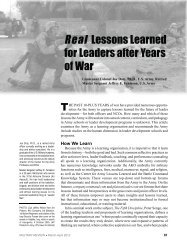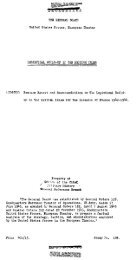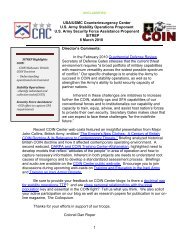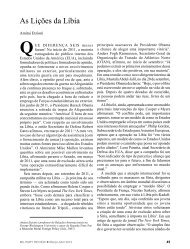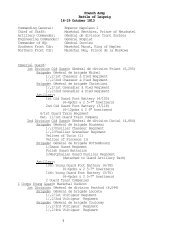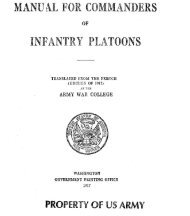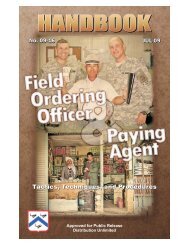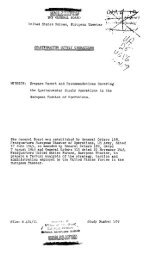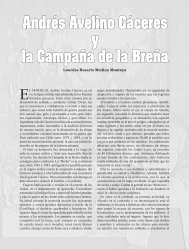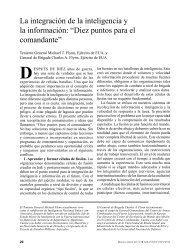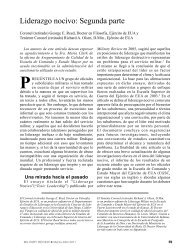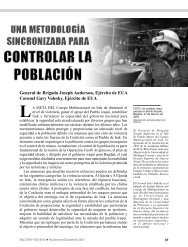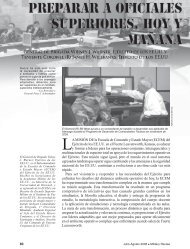Army Leadership Defined - Combined Arms Center - U.S. Army
Army Leadership Defined - Combined Arms Center - U.S. Army
Army Leadership Defined - Combined Arms Center - U.S. Army
Create successful ePaper yourself
Turn your PDF publications into a flip-book with our unique Google optimized e-Paper software.
the desk or screaming at new recruits, or the much<br />
tabooed “touchy-feely” leader, but leaders aware<br />
of their own emotions and how they affect those<br />
around them as they undertake the daily missions<br />
and tasks assigned them. According to psychologist<br />
and author Daniel Goleman, to be successful, a<br />
leader must exercise and be aware of his emotions<br />
and how his emotional competence influences the<br />
way he leads and impacts his followers. 2<br />
FM 6-22 outlines the attributes and competencies<br />
required of <strong>Army</strong> leaders. But who makes up<br />
the <strong>Army</strong>’s corps of leaders? FM 6-22 tells us an<br />
<strong>Army</strong> leader is anyone who, by virtue of assumed<br />
role or assigned responsibility, inspires and influences<br />
people to accomplish organizational goals.<br />
<strong>Army</strong> leaders motivate people both inside and<br />
outside the chain of command to pursue actions,<br />
focus thinking, and shape decisions for the greater<br />
good of the organization. 3 The general public’s<br />
idea of an <strong>Army</strong> leader is the crusty old NCO or<br />
the charismatic officer leading troops into battle or<br />
the well-decorated general giving the inspirational<br />
speech. However, based on the <strong>Army</strong>’s definition,<br />
its leaders are persons that satisfy the responsibilities<br />
within that definition; that is, Soldiers, civilians,<br />
noncommissioned officers, warrant officers, and<br />
commissioned officers; indeed, the full gambit of<br />
personnel in the <strong>Army</strong> system. The <strong>Army</strong> recognizes<br />
that every person has the ability and potential<br />
to be a leader. All of the <strong>Army</strong>’s leaders can benefit<br />
from a greater understanding of their emotions and<br />
the emotions of others.<br />
Emotional Intelligence:<br />
A Brief History<br />
Emotional intelligence is hardly a new field of<br />
study; it is based on a long history of research and<br />
theory in the fields of psychology, human intelligence,<br />
and the social sciences. In his 1983 book<br />
Frames of Mind, Harvard psychologist Howard<br />
Gardner indicates that the study of the emotional<br />
side of intelligence can be traced back to the early<br />
1800s to the studies of Franz Joseph Gall and his<br />
associate, Joseph Spurzheim, who identified the<br />
presence of three affective faculties in the brain—<br />
reverence, self-esteem, and reflective powers. 4<br />
Dr. Reuven BarOn, author and developer of the<br />
Emotional Quotient Inventory, identifies David<br />
Wechsler and his studies on “the nonintellective<br />
aspects of general intelligence” conducted in 1940<br />
as the foundation for the study of emotional intelligence.<br />
5 Some of the most notable groundbreaking<br />
work in the field was done by Gardner. In Frames<br />
of Mind, Gardner proposed that there was not just<br />
one type of intelligence quotient (IQ) that led to<br />
success in life, but a wide spectrum of intelligences<br />
and at least four varieties of interpersonal intelligence.<br />
6 Gardner writes of two types of personal<br />
intelligence that both deal with the emotions. He<br />
speaks of intrapersonal intelligence, which is the<br />
internal aspects of a person, and the interpersonal<br />
intelligence, which turns outward towards other<br />
individuals. 7 Gardner’s groundbreaking work<br />
was further developed by Yale psychologist Peter<br />
Salovey, whose concept of emotional intelligence<br />
included appraising the emotions in self and others,<br />
regulating emotions in self and others, and using<br />
emotions in adaptive ways. 8 These were identified<br />
and described in his 1990 study, conducted with an<br />
associate, Peter Mayer. The term emotional intelligence<br />
was also introduced in this study. 9<br />
Psychologist Daniel Goleman popularized emotional<br />
intelligence with his landmark book of that<br />
name, which became a “household” expression as<br />
well as a field of study worth consideration in the<br />
business, academic, and social-science communities.<br />
Goleman developed his theory about emotional<br />
intelligence through research in more than 200<br />
organizations, explaining that without emotional<br />
intelligence, a person can have first class training,<br />
an incisive mind, and an endless supply of good<br />
ideas, but still not make a great leader. 10 Supported<br />
by his research, Goleman maintained that despite<br />
their cognitive intelligence and business smarts,<br />
executives and managers could not have gained<br />
their levels of success if they had not possessed<br />
emotional intelligence. 11 In his initial research<br />
and theories, based on the findings of Salovey and<br />
Mayer, Goleman adopted a five-domain model,<br />
which he later modified to a four-domain model. 12<br />
…a person can have first class<br />
training, an incisive mind, and an<br />
endless supply of good ideas, but<br />
still not make a great leader.<br />
94 November-December 2009 MILITARY REVIEW



